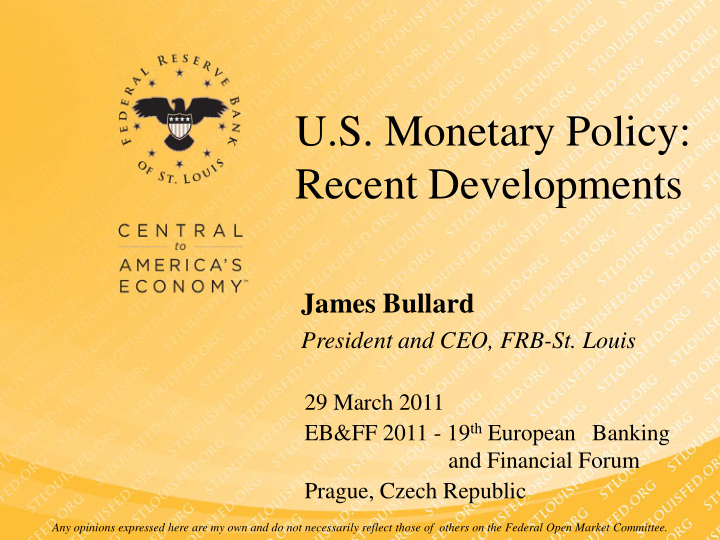



U.S. Monetary Policy: Recent Developments James Bullard President and CEO, FRB-St. Louis 29 March 2011 EB&FF 2011 - 19 th European Banking and Financial Forum Prague, Czech Republic Any opinions expressed here are my own and do not necessarily reflect those of others on the Federal Open Market Committee.
This talk. The situation last summer. Disinflation and declining inflation expectations. Quantitative easing as classic monetary policy. The situation in the first months of 2011. Improved U.S. growth prospects. Increased uncertainty from four sources. The path to normalization. The hard work is ahead.
QE2: classic monetary policy
The FOMC decision The FOMC voted to pursue “QE2” in November 2010. Even before this action, monetary policy was ultra-easy: The policy rate has been near zero for an “extended period.” The Fed’s balance sheet is much larger than it was pre-crisis. After the November meeting, the Committee stated that: The Fed will purchase Treasury securities at a pace of about $75 billion per month through the first half of 2011. The Committee will regularly review the program. Minimal changes at the December, January, and March meetings.
Motivation for QE2 There was a disinflationary trend during 2010. Japanese experience with mild deflation and a near-zero nominal interest rate has been poor. Asset purchases can substitute for ordinary (interest rate targeting) monetary policy.
The effects of asset purchases in financial markets The policy change was largely priced into markets ahead of the November FOMC meeting. The financial market effects were entirely conventional. In particular, real interest rates declined, inflation expectations rose, the dollar depreciated, and equity prices rose. These are the “classic” financial market effects one might observe when the Fed eases monetary policy in ordinary times (that is, in an interest rate targeting environment).
Expected inflation increased Source: Federal Reserve Board. Last observation: March 21, 2011.
Equity prices increased Source: Wall Street Journal. Last observation: March 18, 2011.
The dollar depreciated Source: Federal Reserve Board. Last observation: March 18, 2011.
Real interest rates declined Source: Federal Reserve Board. Last observation: March 18, 2011.
Classic monetary policy easing This experience shows that monetary policy can be eased aggressively even when the policy rate is near zero. Effects on the real economy lag from six to twelve months. Real effects are difficult to disentangle because other shocks hit the economy in the meantime. This is a standard problem in the evaluation of monetary policy.
2011
Better growth prospects in the U.S. U.S. growth prospects improved by early 2011, relative to the summer of 2010. Private sector forecasters and the FOMC all marked up their forecasts. Anecdotal reports were more bullish: Profitable businesses with considerable cash and an improving outlook. Many can tap into the continued boom in emerging Asia. An improving economy 18 months post-recession is generally a strong positive.
The natural debate Quantitative easing has been an effective tool, even while the policy rate is near zero. The economic outlook has improved since the program was implemented. The natural debate is how and when the exit should begin. However … … additional uncertainty has clouded this picture.
Uncertainty from four sources In recent weeks, macroeconomic uncertainty has been on the rise from four key sources. One has been turmoil in the Middle East and North Africa, 1. and the associated uncertainty premium in oil prices. Another has been the natural disaster in Japan and the 2. damaged nuclear reactors there. A third has been the U.S. fiscal situation and the possibility 3. of a government shutdown. And finally, continued uncertainty regarding resolution of 4. the European sovereign debt crisis.
Prospects are for each situation to be contained All four situations contain potential for escalation. If escalation occurs, all bets are off. Still, the most likely prospect is that all four are resolved without becoming global macroeconomic shocks.
Normalization
Normalization U.S. monetary policy cannot remain ultra-accommodative indefinitely. The process of normalizing policy, even once it begins, will still leave unprecedented policy accommodation on the table. The FOMC may not be willing or able to wait until all global uncertainties are resolved to begin normalizing policy. Exit strategy was widely discussed in 2010, and that debate will likely revive during 2011.
More on normalization Normal monetary policy has two parts: QE accommodation is removed by returning the balance sheet to an ordinary size over time. The policy rate begins to approach levels associated with moderate expansion. This will take time. This is the most difficult part of the business cycle for a central bank.
Conclusions
Conclusion QE2 was a classic easing of monetary policy. U.S. growth prospects remain reasonably good for 2011. Recent events present considerable uncertainty, but can be resolved in benign ways. Discussion of the normalization of U.S. policy will likely return as the key issue in 2011.
Federal Reserve Bank of St. Louis stlouisfed.org Federal Reserve Economic Data (FRED) research.stlouisfed.org/fred2/ James Bullard research.stlouisfed.org/econ/bullard/
Recommend
More recommend